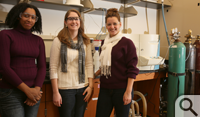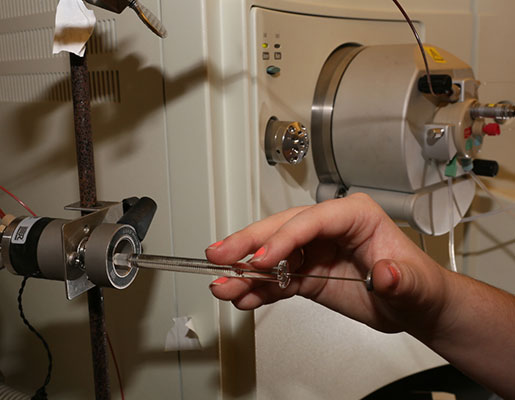2013-the-phage
Freshman lab evolves into study of proteomics
It was a hard act to follow.
What could possibly be a follow-up to a group of freshmen discovering a new form of life and finding new genes in its genome?
The discoveries were made in the phage lab, part of a science education and research program at William & Mary sponsored by the Howard Hughes Medical Institute (HHMI). The idea is to immerse a group of the university’s youngest students in a real-world research experience. This particular experience centers on bacteriophages—phages for short—a class of viruses that infect bacteria.
 In 2008, the first freshman phage lab discovered a set of
bacteriophages, including one phage found in Crim Dell that was previously
unknown to science. They dubbed their discovery CrimD
and began to study the genome of the virus, which revealed some genes that were
strikingly different from any viral genes ever seen. As that first big year was
winding down, there was a shared sense of not wanting it to end.
In 2008, the first freshman phage lab discovered a set of
bacteriophages, including one phage found in Crim Dell that was previously
unknown to science. They dubbed their discovery CrimD
and began to study the genome of the virus, which revealed some genes that were
strikingly different from any viral genes ever seen. As that first big year was
winding down, there was a shared sense of not wanting it to end.
“You guys should really have a follow-up course for this—something that we can continue all the cool research that we did,” said one student.
What’s the next logical step after bacteriophages?
“We kind of just stared at one another and said yes, that’s a really good idea,” recalled Margaret Saha. Saha, Chancellor Professor of Biology, is the program director for the HHMI initiatives at William & Mary. She has taught the phage lab in collaboration with fellow biologists Mark Forsyth and Kurt Williamson.
The biologists talked it over and decided the next logical step from bacteriophage genomics would be to investigate bacteriophage proteomics. Proteomics is the study of the structure and function of proteins, the molecules that carry out basic cellular functions. It lies in the increasingly hazy borderlands between “biology” and “chemistry.”
They enlisted J.C. Poutsma from the chemistry department. Together, the group sought funding from HHMI in its 2010 Science Education Grant application for extending the successful phage lab concept into a year-long, upper-level undergraduate proteomics lab.
“We were very pleased that our grant was funded,” Saha said. “HHMI is very interested in fostering interdisciplinary research—and we thought it would be enormous fun to work with J.C.”
Enter the virtuoso at mass spectrometry
In addition to being a vibrant collaborator, Poutsma is a virtuoso at mass spectrometry, a technique used for identification of chemical compounds at the molecular level. The examination of any of the hundreds of thousands of proteins that are the chemical building blocks of all organisms absolutely requires mass spectrometry and an interdisciplinary focus.
Poutsma doesn’t use the word “interdisciplinary,” but rather describes the proteomics lab as “trying to tear apart the whole biology-chemistry dichotomy,” as William & Mary’s chemistry and biology majors are able to conduct research at a point where their fields overlap. He noted that other boundaries have come down, as well.
“I thought when we first started that this was probably going to be a senior-level lab, but it turns out that we’ve got sophomore and juniors and seniors in there,” Poutsma said. “There are not very many opportunities for majors across years to be actually interacting with each other, so it’s good to have not only the chemistry-biology thing but also this lab puts the younger students with the ones that are getting ready to go to grad school.”
Phages have to make a living, just like the rest of us
The proteomics lab studies proteins from bacteriophages discovered by phage lab students. Williamson is a virologist and explains that genes program the various processes phages need to make a living.
“All living organisms have to take in nutrients, they have to grow, they have to reproduce, they get rid of waste,” Williamson explained, but he noted that different organisms use different strategies.
“The multitude of forms that you see on planet Earth is just one indication that there are many ways to be successful,” he said. “Viruses, same thing: They have to infect a host and get inside, they have to express their genes in the right order, they have to make their progeny and they have to escape the cell. But there are many ways in which to accomplish that.”
The lab is working to determine the function of individual phage genes by examining their proteins. Forsyth said their strategy starts by looking at individual proteins that show up at different points during the process in which the bacteriophages infect bacterial hosts.
“If we can identify at what point in the cycle they’re expressed, that may give us our first clue as to their function,” he said, adding that there are some rules of thumb to start with.
“Genes that are expressed late are often involved in maturation of the virus, so they’re not needed at the beginning,” Forsyth explained. “Genes at the beginning maybe are more involved with DNA replication.”
Making big ones into little ones: Proteins into peptides
Working in the third-floor labs in William & Mary’s Integrated Science Center, the proteomics students isolate proteins from phage specimens, using a laboratory technique known as gel electrophoresis. Once the proteins are isolated, the students use an enzyme process to break them down into peptides—chains of amino acids.
Once a protein is chopped into peptides, it’s ready to go down to the first floor of the ISC and Poutsma’s mass spectrometry lab. Poutsma described a mass spectrometer as a “really, really big balance,” accurate enough to weigh teeny fragments of protein. He teaches the students how to recognize peptides by the way they split and by weight.
“Peptides generally fragment in very recognizable and repeatable ways,” he said. “Since each amino acid has a different side chain and each one of those side chains has a different molecular mass—a different weight, you can actually figure out the sequence of amino acids in your peptide. It’s sort of like putting a puzzle together.”
As in all “real” research, the students don’t know if their work will assemble enough pieces of the phage proteomics puzzle together to get near a solution. Neither do their professors, who point out that uncertainty of outcome is part of the life of a scientist.
“I think it’s important to teach these students that
research doesn’t always work,” Poutsma said. “Sometimes we have great ideas and
they don’t always pan out the way that we think they’re going to. But then you
have to look at why it didn’t work. Did it not work because I didn’t put all
the chemicals in or is it because I need to look at this from a whole new
direction?” ![]()
This story appeared in the spring, 2013 issue of the William & Mary Alumni Magazine.
















